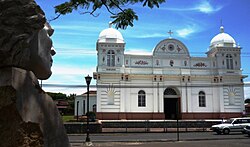Barva is the second canton in the province of Heredia in Costa Rica.[1][2]
Barva | |
|---|---|
 Parish of Saint Bartholomew the Apostle and Barvak sculpture | |
 Barva canton | |
| Coordinates: 10°04′35″N 84°06′56″W / 10.0763757°N 84.115545°W | |
| Country | |
| Province | Heredia |
| Government | |
| • Type | Municipality |
| • Body | Municipalidad de Barva |
| Area | |
• Total | 53.8 km2 (20.8 sq mi) |
| Elevation | 1,241 m (4,072 ft) |
| Population (2011) | |
• Total | 40,660 |
| • Density | 760/km2 (2,000/sq mi) |
| Time zone | UTC−06:00 |
| Canton code | 402 |
| Website | munibarva |
The head city of the canton is the homonymous Barva district.
Toponymy
editThe name comes from Barvac or Barvak a cacique of the area around 1569, which in turn might come from either:
- From New Tlapallan in Nahuatl language, or Tla pallapan, which in Huetar language was Tabaraba or Abaraba, hispanicized as Barba and meaning Black River or Dark River as explained by José Fidel Tristán in 1910.[3][4]
- Bal (town) and wac (anteater), meaning Anteater Town, according to Luis Ferrero.[4]
- Bar or bur (bees) with ba or bac (tribe), meaning Bees Tribe, as explained by bishop Bernardo Augusto Thiel y Hoffmann in late 19th century, from sources from 1575 and 1599.[4]
By Decree 188 of 4 October 1974, the name changes from Barba to Barva.
History
editBarva was first mentioned as a canton in a decree dated December 7, 1848.
The territory that today corresponds to the canton was part of the Western Huetar Kingdom, where the cacique named Barbak had his settlement, whose name was extended to the region between the Virilla River and the mountains of "Monte de Aguacate", which was called Barva (Valle de Barva).
Around 1575 the first Catholic church of the canton was built, and dedicated to Saint Bartholomew, after several earthquakes and reconstructions, the current building of the Parish of Saint Bartholomew the Apostle was consecrated in 1897.
On the slopes of the volcanoes Barva Barva Volcano and Poás Poás Volcano National Park there were also settlements of the indigenous ethnic group of Botos people.
Geography
editBarva has an area of 53.8 km2[5] and an elevation of 1,241 metres.[1]
The elongated canton climbs from the city of Barva on the outskirts of the capital city of Heredia up the slopes of the dormant Barva Volcano, with the mountain's summit serving as its northern boundary.
The mountainous region of the canton, where the lagoon of the Barva volcano is located, is part of the area protected by the Braulio Carrillo National Park. Barva is also the access point to the Poás Volcano National Park, the most visited in the country.
Many aquifers around the area supply water for the Greater Metropolitan Area.
Districts
editThe canton of Barva is subdivided into six districts.
Demographics
edit| Census | Pop. | ±% p.a. |
|---|---|---|
| 1864 | 3,718 | — |
| 1883 | 2,663 | −1.74% |
| 1892 | 2,964 | +1.20% |
| 1927 | 3,482 | +0.46% |
| 1950 | 5,263 | +1.81% |
| 1963 | 8,504 | +3.76% |
| 1973 | 12,864 | +4.23% |
| 1984 | 18,933 | +3.58% |
| 2000 | 32,440 | +3.42% |
| 2011 | 40,660 | +2.07% |
| 2022 | 47,699 | +1.46% |
| Source: Instituto Nacional de Estadística y Censos[6] Centro Centroamericano de Población[7] | ||
For the 2011 census, Barva had a population of 40,660 inhabitants.[8]
The town has a high literacy rate of (99%), and by 2012 it had a high rate of human development of (0.829) United Nations Development Program.[9]
Transportation
editRoad transportation
editThe canton is covered by the following road routes:
Economy
editThe mountains of the region are appropriate for the agriculture. There are plenty of coffee plantations around the slopes of the Barva Volcano. There is also dairy production.
Culture
editThe canton of Barva is known for its mix between rural and urban. The historic centre of the city has several adobe houses Colonial style classic architecture. The Saint "patron of the city" is Bartholomew the Apostle, reason why the Catholic church was named to honor Saint Bartholomew.
Barva is one of the cantons where there are traditional masquerades, particularly around the festivities of Saint Bartholomew, on 24 August.
References
edit- ^ a b "Declara oficial para efectos administrativos, la aprobación de la División Territorial Administrativa de la República N°41548-MGP". Sistema Costarricense de Información Jurídica (in Spanish). 19 March 2019. Retrieved 26 September 2020.
- ^ División Territorial Administrativa de la República de Costa Rica (PDF) (in Spanish). Editorial Digital de la Imprenta Nacional. 8 March 2017. ISBN 978-9977-58-477-5.
- ^ Gagini, Carlos (1917). Los aborigenes de Costa Rica.
- ^ a b c Guillermo E. Alvarado Induni; Oscar Luis Chavarría-Aguilar, Guillermo E Alvarado Induni (2005). Costa Rica: Land of Volcanoes. EUNED. pp. 212–213. ISBN 978-9968-31-366-7.
- ^ "Área en kilómetros cuadrados, según provincia, cantón y distrito administrativo". Instituto Nacional de Estadística y Censos (in Spanish). Archived from the original on 24 October 2020. Retrieved 26 September 2020.
- ^ "Instituto Nacional de Estadística y Censos" (in Spanish).
- ^ Centro Centroamericano de Población de la Universidad de Costa Rica. "Sistema de Consulta a Bases de Datos Estadísticas" (in Spanish).
- ^ "Censo. 2011. Población total por zona y sexo, según provincia, cantón y distrito". Instituto Nacional de Estadística y Censos (in Spanish). Retrieved 26 September 2020.
- ^ "Copia archivada". Archived from the original on 5 March 2016. Retrieved 18 March 2016.


